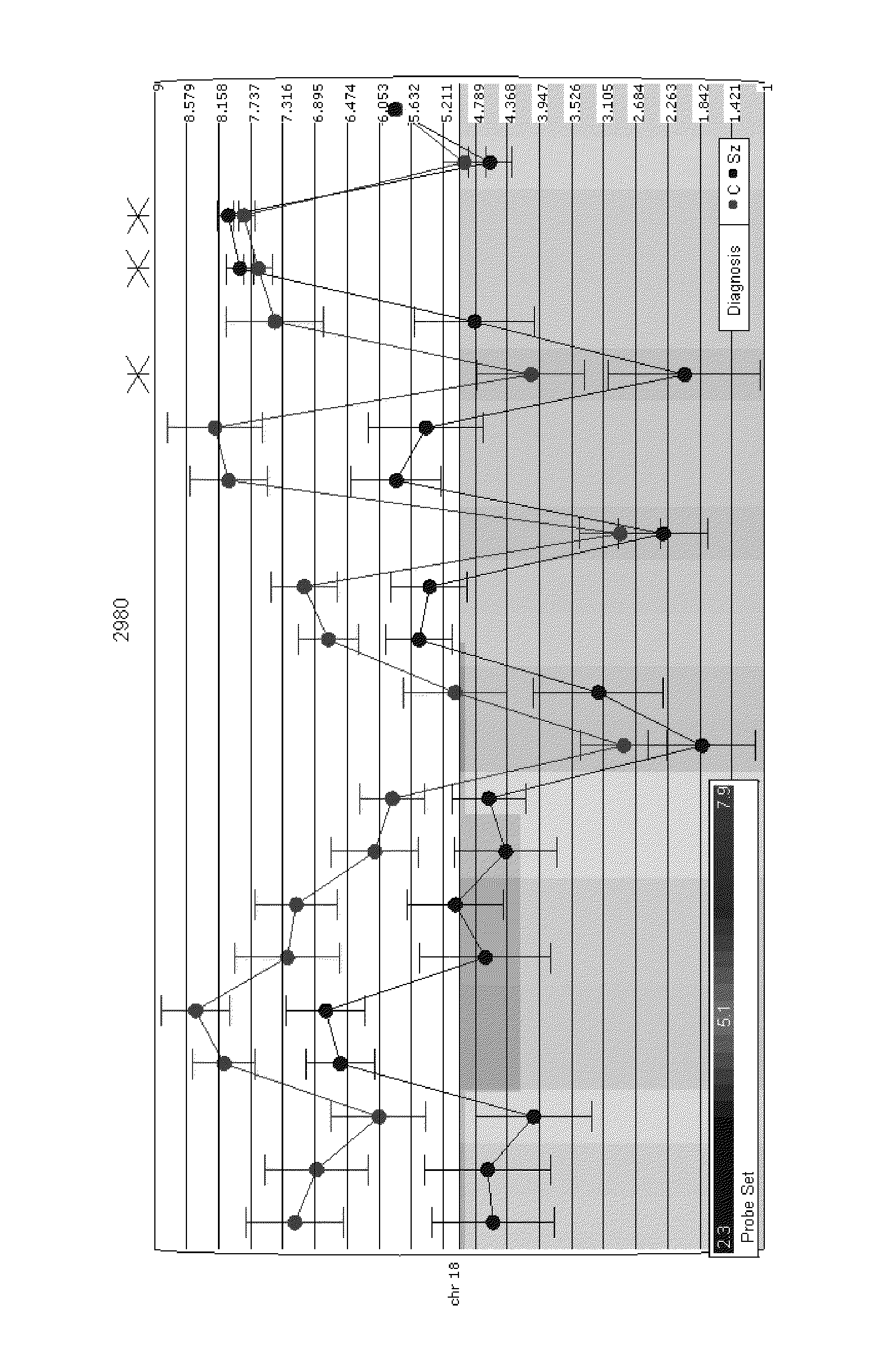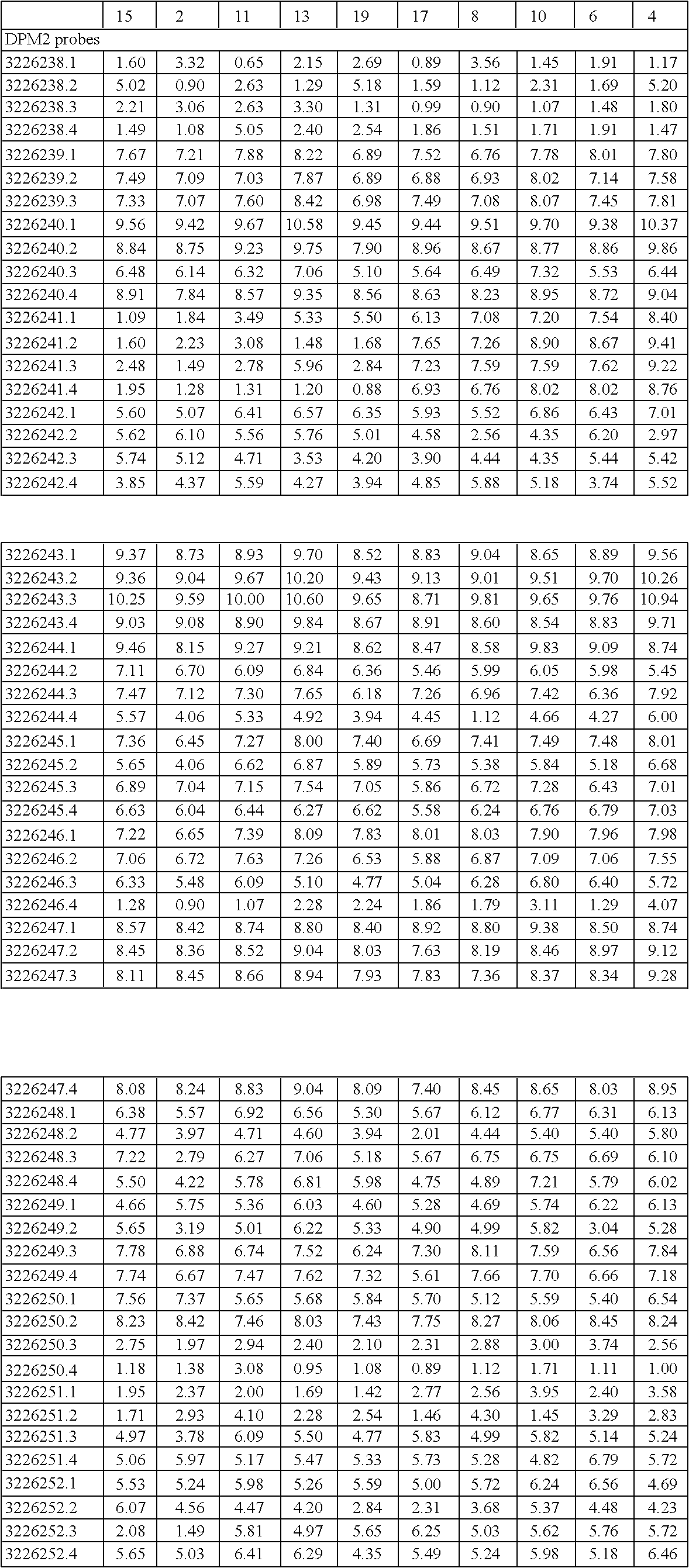SNP detection and other methods for characterizing and treating bipolar disorder and other ailments
a technology of applied in the field of snp detection and other methods for characterizing and treating bipolar disorder and other ailments, can solve the problems of ineffective and reliable diagnosis and rate, lack of biomarkers, and difficulty in diagnosing bipolar disorder
- Summary
- Abstract
- Description
- Claims
- Application Information
AI Technical Summary
Benefits of technology
Problems solved by technology
Method used
Image
Examples
example 1
Whole Genome Study to Identify SNPs Associated with BP Disease
[0236]This example compares the genotype frequencies of BPI individuals to control individuals with no reported BPI, schizophrenia or major depression.
[0237]Sample selection: 1,160 Bipolar I (BPI) cases were selected from Distribution 3.07 of the NIMH Human Genetics Initiative repository and 57 Bipolar I cases from the Heinz Prechter repository of the University of Michigan Depression Center. The NIMH cases were diagnosed with BPI and came from 10 study sites within the United States. Of available families, we initially selected one BPI individual with ethnicity reported as described below. When available, we also selected a second BPI sibling. Sibships containing the proband were preferentially selected. In total, 489 sibpairs and 182 singleton BPI cases were selected. Subjects from the Prechter repository were either self-referred (by an advertisement on the depression center's Website) or were recruited during a clinic...
example 2
Candidate Gene Study to Identify SNPs Associated with BP Disease
[0249]A candidate gene approach was taken to identify loci associated with BP. The approach involved genotyping 466 bipolar cases and 465 controls for 1,727 SNPs located in 93 genes. The bipolar cases are from the NIMH Human Genetics Initiative's collection and the controls are ethnically matched NIMH control samples that have completed a psychiatric screen. The 93 genes were selected based on their association with bipolar disease, as well as their aberrant expression in our microarray experiments with human brain mRNA, and their implication in animal models with similar phenotypes. SNPs from Illumina's HumanHap550 arrays were selected that reside in regions 20 kb upstream and 10 kb downstream from each of the 93 candidate genes. The genotyped HumanHap550 chip covers a substantial fraction of the common genetic variation in individuals of European origin.
[0250]Genotyping was performed using the Infinium assay on Illumi...
example 3
Differential Exon Expression in Schizophrenia
[0253]The positive symptoms of schizophrenia can look like the symptoms in manic episodes, especially those with psychotic features (e.g., delusions of grandeur, hallucinations, disorganized speech, paranoia, etc.). The negative symptoms of schizophrenia can closely resemble the symptoms of a depressive episode (these include apathy, extreme emotional withdrawal, lack of affect, low energy, social isolation, etc.). Thus, objective molecular measurements that provide information relevant to diagnosis schizophrenia are very useful to clinicians and researchers. The following examples demonstrate how such measurements may be obtained.
[0254]Ten Affymetrix human exon arrays were hybridized with cDNA from five individual schizophrenia subjects and five unaffected family members. The experiment was repeated with the same samples and the data is presented as averages for each group (Schizophrenia and Controls). The plot for the transcript DSC2 (d...
PUM
| Property | Measurement | Unit |
|---|---|---|
| molecular weight | aaaaa | aaaaa |
| molecular weight | aaaaa | aaaaa |
| molecular weight | aaaaa | aaaaa |
Abstract
Description
Claims
Application Information
 Login to View More
Login to View More - R&D
- Intellectual Property
- Life Sciences
- Materials
- Tech Scout
- Unparalleled Data Quality
- Higher Quality Content
- 60% Fewer Hallucinations
Browse by: Latest US Patents, China's latest patents, Technical Efficacy Thesaurus, Application Domain, Technology Topic, Popular Technical Reports.
© 2025 PatSnap. All rights reserved.Legal|Privacy policy|Modern Slavery Act Transparency Statement|Sitemap|About US| Contact US: help@patsnap.com



